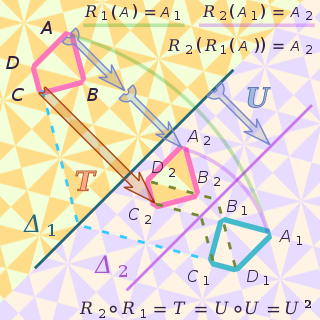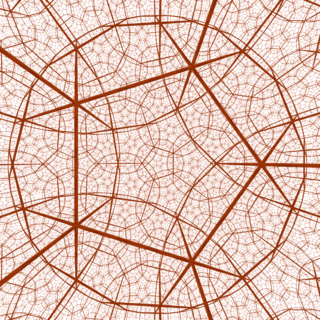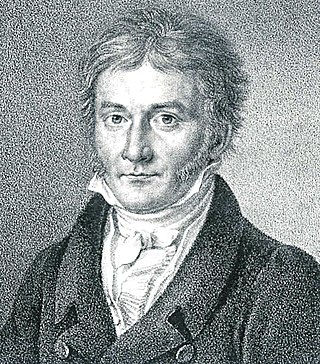
In mathematics, a metric space is a set together with a notion of distance between its elements, usually called points. The distance is measured by a function called a metric or distance function. Metric spaces are the most general setting for studying many of the concepts of mathematical analysis and geometry.

In mathematics, an isometry is a distance-preserving transformation between metric spaces, usually assumed to be bijective. The word isometry is derived from the Ancient Greek: ἴσος isos meaning "equal", and μέτρον metron meaning "measure". If the transformation is from a metric space to itself, it is a kind of geometric transformation known as a motion.

In mathematics, hyperbolic space of dimension n is the unique simply connected, n-dimensional Riemannian manifold of constant sectional curvature equal to -1. It is homogeneous, and satisfies the stronger property of being a symmetric space. There are many ways to construct it as an open subset of with an explicitly written Riemannian metric; such constructions are referred to as models. Hyperbolic 2-space, H2, which was the first instance studied, is also called the hyperbolic plane.
In mathematics, real trees are a class of metric spaces generalising simplicial trees. They arise naturally in many mathematical contexts, in particular geometric group theory and probability theory. They are also the simplest examples of Gromov hyperbolic spaces.
This is a glossary of some terms used in Riemannian geometry and metric geometry — it doesn't cover the terminology of differential topology.
In mathematics, a hyperbolic metric space is a metric space satisfying certain metric relations between points. The definition, introduced by Mikhael Gromov, generalizes the metric properties of classical hyperbolic geometry and of trees. Hyperbolicity is a large-scale property, and is very useful to the study of certain infinite groups called Gromov-hyperbolic groups.
In group theory, a word metric on a discrete group is a way to measure distance between any two elements of . As the name suggests, the word metric is a metric on , assigning to any two elements , of a distance that measures how efficiently their difference can be expressed as a word whose letters come from a generating set for the group. The word metric on G is very closely related to the Cayley graph of G: the word metric measures the length of the shortest path in the Cayley graph between two elements of G.
In mathematics, the Teichmüller space of a (real) topological surface is a space that parametrizes complex structures on up to the action of homeomorphisms that are isotopic to the identity homeomorphism. Teichmüller spaces are named after Oswald Teichmüller.
In geometric topology, Busemann functions are used to study the large-scale geometry of geodesics in Hadamard spaces and in particular Hadamard manifolds. They are named after Herbert Busemann, who introduced them; he gave an extensive treatment of the topic in his 1955 book "The geometry of geodesics".

In group theory, more precisely in geometric group theory, a hyperbolic group, also known as a word hyperbolic group or Gromov hyperbolic group, is a finitely generated group equipped with a word metric satisfying certain properties abstracted from classical hyperbolic geometry. The notion of a hyperbolic group was introduced and developed by Mikhail Gromov (1987). The inspiration came from various existing mathematical theories: hyperbolic geometry but also low-dimensional topology, and combinatorial group theory. In a very influential chapter from 1987, Gromov proposed a wide-ranging research program. Ideas and foundational material in the theory of hyperbolic groups also stem from the work of George Mostow, William Thurston, James W. Cannon, Eliyahu Rips, and many others.
In differential geometry, the Margulis lemma is a result about discrete subgroups of isometries of a non-positively curved Riemannian manifold. Roughly, it states that within a fixed radius, usually called the Margulis constant, the structure of the orbits of such a group cannot be too complicated. More precisely, within this radius around a point all points in its orbit are in fact in the orbit of a nilpotent subgroup.
In the mathematical subject of geometric group theory, the Culler–Vogtmann Outer space or just Outer space of a free group Fn is a topological space consisting of the so-called "marked metric graph structures" of volume 1 on Fn. The Outer space, denoted Xn or CVn, comes equipped with a natural action of the group of outer automorphisms Out(Fn) of Fn. The Outer space was introduced in a 1986 paper of Marc Culler and Karen Vogtmann, and it serves as a free group analog of the Teichmüller space of a hyperbolic surface. Outer space is used to study homology and cohomology groups of Out(Fn) and to obtain information about algebraic, geometric and dynamical properties of Out(Fn), of its subgroups and individual outer automorphisms of Fn. The space Xn can also be thought of as the set of Fn-equivariant isometry types of minimal free discrete isometric actions of Fn on Fn on R-treesT such that the quotient metric graph T/Fn has volume 1.

In mathematics, the differential geometry of surfaces deals with the differential geometry of smooth surfaces with various additional structures, most often, a Riemannian metric. Surfaces have been extensively studied from various perspectives: extrinsically, relating to their embedding in Euclidean space and intrinsically, reflecting their properties determined solely by the distance within the surface as measured along curves on the surface. One of the fundamental concepts investigated is the Gaussian curvature, first studied in depth by Carl Friedrich Gauss, who showed that curvature was an intrinsic property of a surface, independent of its isometric embedding in Euclidean space.
In mathematics, an ultralimit is a geometric construction that assigns a limit metric space to a sequence of metric spaces . The concept captures the limiting behavior of finite configurations in the spaces employing an ultrafilter to bypass the need for repeatedly consideration of subsequences to ensure convergence. Ultralimits generalize Gromov Hausdorff convergence in metric spaces.
In the mathematical subject of geometric group theory, a Dehn function, named after Max Dehn, is an optimal function associated to a finite group presentation which bounds the area of a relation in that group in terms of the length of that relation. The growth type of the Dehn function is a quasi-isometry invariant of a finitely presented group. The Dehn function of a finitely presented group is also closely connected with non-deterministic algorithmic complexity of the word problem in groups. In particular, a finitely presented group has solvable word problem if and only if the Dehn function for a finite presentation of this group is recursive. The notion of a Dehn function is motivated by isoperimetric problems in geometry, such as the classic isoperimetric inequality for the Euclidean plane and, more generally, the notion of a filling area function that estimates the area of a minimal surface in a Riemannian manifold in terms of the length of the boundary curve of that surface.

In mathematics, the Gromov boundary of a δ-hyperbolic space is an abstract concept generalizing the boundary sphere of hyperbolic space. Conceptually, the Gromov boundary is the set of all points at infinity. For instance, the Gromov boundary of the real line is two points, corresponding to positive and negative infinity.
In the mathematical subject of geometric group theory, the Švarc–Milnor lemma is a statement which says that a group , equipped with a "nice" discrete isometric action on a metric space , is quasi-isometric to .
In metric geometry, asymptotic dimension of a metric space is a large-scale analog of Lebesgue covering dimension. The notion of asymptotic dimension was introduced by Mikhail Gromov in his 1993 monograph Asymptotic invariants of infinite groups in the context of geometric group theory, as a quasi-isometry invariant of finitely generated groups. As shown by Guoliang Yu, finitely generated groups of finite homotopy type with finite asymptotic dimension satisfy the Novikov conjecture. Asymptotic dimension has important applications in geometric analysis and index theory.
In the mathematical subject of group theory, a co-Hopfian group is a group that is not isomorphic to any of its proper subgroups. The notion is dual to that of a Hopfian group, named after Heinz Hopf.
In the mathematical subject of geometric group theory, an acylindrically hyperbolic group is a group admitting a non-elementary 'acylindrical' isometric action on some geodesic hyperbolic metric space. This notion generalizes the notions of a hyperbolic group and of a relatively hyperbolic group and includes a significantly wider class of examples, such as mapping class groups and Out(Fn).























































